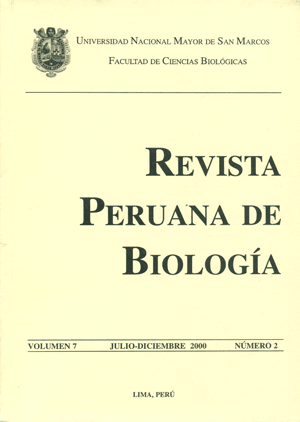Biology, comercial catch and potencial use of tucunare (Cichla monoculus, Pisces: Cichlidae) in Ucayali, Perú
DOI:
https://doi.org/10.15381/rpb.v7i2.6817Keywords:
ucunare, Cichla monoculus, Amazon fisheries, Ucayali, Peru.Abstract
Biological characterization of fisheries is essential for an adequate use and management. From February 1999 to January 2000 length-weight ratio, global sexual proportion, egg laying season, mature length, and feeding habit data were recorded from 250 specimens of Cichla monoculus "tucunaré". The standard length (SL) - eviscerated weight (SL-EW) ratio is isometric for both males and females with a joint relation EW = 0,0184* SL 3,0963. Global sexual proportion is near 1:1. Egg laying is during the Ucayali river wet season (October-January). Calculated mature length for females is about 26,5 cm SL and it is proposed as catch length for regulatory purposes. Tucunare feeds mainly from fishes, predominantly median and small Characiformes (Cheirodon. Ctenobrycon, Hoplias, Leporinus and Psectrogaster. But also Siluriformes (Corydoras, Hypostominae, Loricariinae, Pimelodidae), Perciformes (Aequidens, Crenicichla) and Gymnotiformes (Sternopygidae) which suggests that the feeding occurs at daylight and sunset. C. monoculus has potential use for fish farming, specially in extensive method. Coming from lentic environments, it reproduces naturally annually, and can also be used as a fish controller.Downloads
Downloads
Published
Issue
Section
License
Copyright (c) 2000 José C. Riofrío, Javier E. Zaldívar, César A. Villanueva, Daniel A. Velarda

This work is licensed under a Creative Commons Attribution-NonCommercial-ShareAlike 4.0 International License.
AUTHORS RETAIN THEIR RIGHTS:
a. Authors retain their trade mark rights and patent, and also on any process or procedure described in the article.
b. Authors retain their right to share, copy, distribute, perform and publicly communicate their article (eg, to place their article in an institutional repository or publish it in a book), with an acknowledgment of its initial publication in the Revista Peruana de Biologia.
c. Authors retain theirs right to make a subsequent publication of their work, to use the article or any part thereof (eg a compilation of his papers, lecture notes, thesis, or a book), always indicating its initial publication in the Revista Peruana de Biologia (the originator of the work, journal, volume, number and date).






